中国戏剧英文介绍..
- 格式:ppt
- 大小:4.37 MB
- 文档页数:13
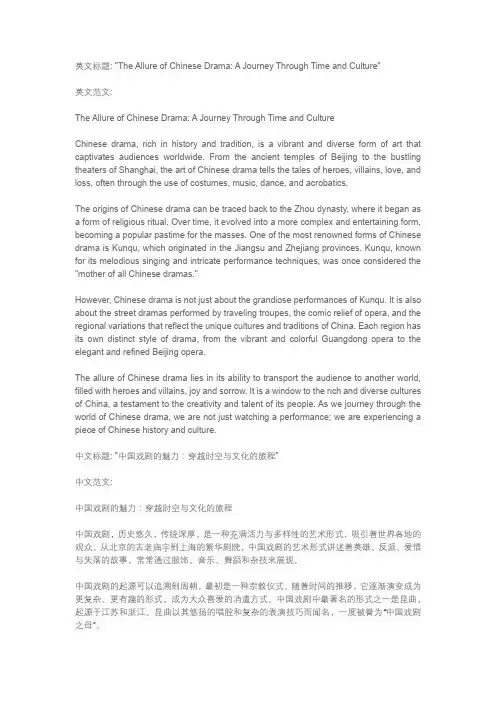
英文标题: "The Allure of Chinese Drama: A Journey Through Time and Culture"英文范文:The Allure of Chinese Drama: A Journey Through Time and CultureChinese drama, rich in history and tradition, is a vibrant and diverse form of art that captivates audiences worldwide. From the ancient temples of Beijing to the bustling theaters of Shanghai, the art of Chinese drama tells the tales of heroes, villains, love, and loss, often through the use of costumes, music, dance, and acrobatics.The origins of Chinese drama can be traced back to the Zhou dynasty, where it began as a form of religious ritual. Over time, it evolved into a more complex and entertaining form, becoming a popular pastime for the masses. One of the most renowned forms of Chinese drama is Kunqu, which originated in the Jiangsu and Zhejiang provinces. Kunqu, known for its melodious singing and intricate performance techniques, was once considered the "mother of all Chinese dramas."However, Chinese drama is not just about the grandiose performances of Kunqu. It is also about the street dramas performed by traveling troupes, the comic relief of opera, and the regional variations that reflect the unique cultures and traditions of China. Each region has its own distinct style of drama, from the vibrant and colorful Guangdong opera to the elegant and refined Beijing opera.The allure of Chinese drama lies in its ability to transport the audience to another world, filled with heroes and villains, joy and sorrow. It is a window to the rich and diverse cultures of China, a testament to the creativity and talent of its people. As we journey through the world of Chinese drama, we are not just watching a performance; we are experiencing a piece of Chinese history and culture.中文标题: "中国戏剧的魅力:穿越时空与文化的旅程"中文范文:中国戏剧的魅力:穿越时空与文化的旅程中国戏剧,历史悠久,传统深厚,是一种充满活力与多样性的艺术形式,吸引着世界各地的观众。
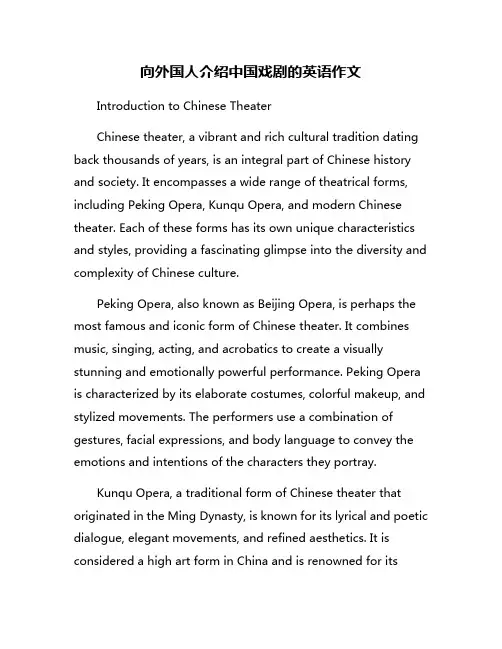
向外国人介绍中国戏剧的英语作文Introduction to Chinese TheaterChinese theater, a vibrant and rich cultural tradition dating back thousands of years, is an integral part of Chinese history and society. It encompasses a wide range of theatrical forms, including Peking Opera, Kunqu Opera, and modern Chinese theater. Each of these forms has its own unique characteristics and styles, providing a fascinating glimpse into the diversity and complexity of Chinese culture.Peking Opera, also known as Beijing Opera, is perhaps the most famous and iconic form of Chinese theater. It combines music, singing, acting, and acrobatics to create a visually stunning and emotionally powerful performance. Peking Opera is characterized by its elaborate costumes, colorful makeup, and stylized movements. The performers use a combination of gestures, facial expressions, and body language to convey the emotions and intentions of the characters they portray.Kunqu Opera, a traditional form of Chinese theater that originated in the Ming Dynasty, is known for its lyrical and poetic dialogue, elegant movements, and refined aesthetics. It is considered a high art form in China and is renowned for itsintricate storytelling and beautiful music. Kunqu Opera often features themes of love, loyalty, and heroism, and its performances are marked by a sense of grace and elegance.In addition to these traditional forms of Chinese theater, modern Chinese theater has also flourished in recent years, with playwrights and directors exploring new themes and pushing the boundaries of traditional conventions. Contemporary Chinese theater often addresses social and political issues, reflecting the changing realities of modern Chinese society.Overall, Chinese theater is a diverse and dynamic art form that offers a window into the rich cultural heritage and artistic traditions of China. Whether you are a theater enthusiast or simply curious about Chinese culture, exploring Chinese theater can be a rewarding and enlightening experience.In conclusion, Chinese theater is an integral part of Chinese culture and history, reflecting the traditions, values, and aspirations of the Chinese people. Whether you are a theater enthusiast or simply interested in learning more about Chinese culture, exploring Chinese theater can provide a valuable insight into the beauty and complexity of Chinese art and society. So next time you have the opportunity, be sure to experience the magic of Chinese theater for yourself.。
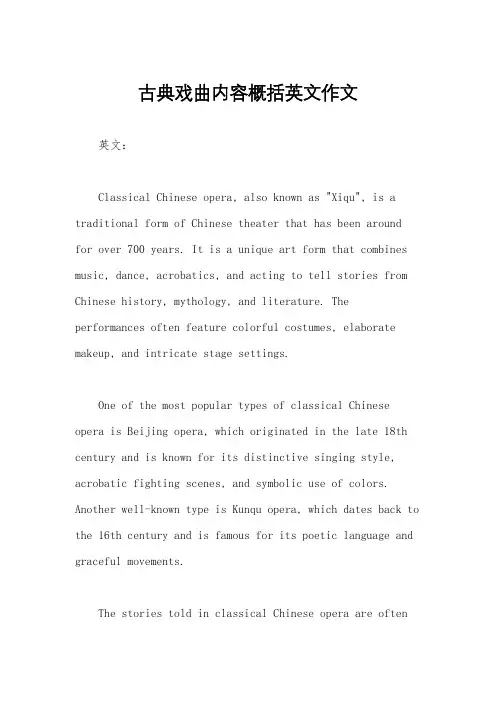
古典戏曲内容概括英文作文英文:Classical Chinese opera, also known as "Xiqu", is a traditional form of Chinese theater that has been aroundfor over 700 years. It is a unique art form that combines music, dance, acrobatics, and acting to tell stories from Chinese history, mythology, and literature. The performances often feature colorful costumes, elaborate makeup, and intricate stage settings.One of the most popular types of classical Chinese opera is Beijing opera, which originated in the late 18th century and is known for its distinctive singing style, acrobatic fighting scenes, and symbolic use of colors. Another well-known type is Kunqu opera, which dates back to the 16th century and is famous for its poetic language and graceful movements.The stories told in classical Chinese opera are oftenbased on historical events or famous literary works. For example, one of the most famous works in Beijing opera is "The Legend of the White Snake", which tells the story of a snake spirit who falls in love with a mortal man and faces opposition from both the human and spirit worlds. Another popular work is "The Peony Pavilion", a Kunqu opera thattells the story of a young woman who falls in love with a scholar in a dream and eventually dies of lovesickness.In addition to the stories themselves, classical Chinese opera also has a rich cultural significance. It is seen as a way to preserve traditional Chinese values and promote national unity. The performers are highly trained and respected artists, and the art form has been recognized by UNESCO as an Intangible Cultural Heritage of Humanity.中文:古典戏曲,也称为“戏曲”,是一种传统的中国戏剧形式,已有700多年的历史。
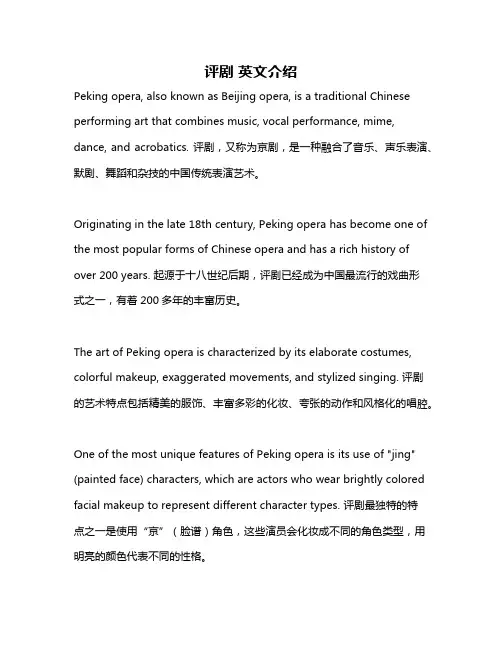
评剧英文介绍Peking opera, also known as Beijing opera, is a traditional Chinese performing art that combines music, vocal performance, mime, dance, and acrobatics. 评剧,又称为京剧,是一种融合了音乐、声乐表演、默剧、舞蹈和杂技的中国传统表演艺术。
Originating in the late 18th century, Peking opera has become one of the most popular forms of Chinese opera and has a rich history of over 200 years. 起源于十八世纪后期,评剧已经成为中国最流行的戏曲形式之一,有着200多年的丰富历史。
The art of Peking opera is characterized by its elaborate costumes, colorful makeup, exaggerated movements, and stylized singing. 评剧的艺术特点包括精美的服饰、丰富多彩的化妆、夸张的动作和风格化的唱腔。
One of the most unique features of Peking opera is its use of "jing" (painted face) characters, which are actors who wear brightly colored facial makeup to represent different character types. 评剧最独特的特点之一是使用“京”(脸谱)角色,这些演员会化妆成不同的角色类型,用明亮的颜色代表不同的性格。
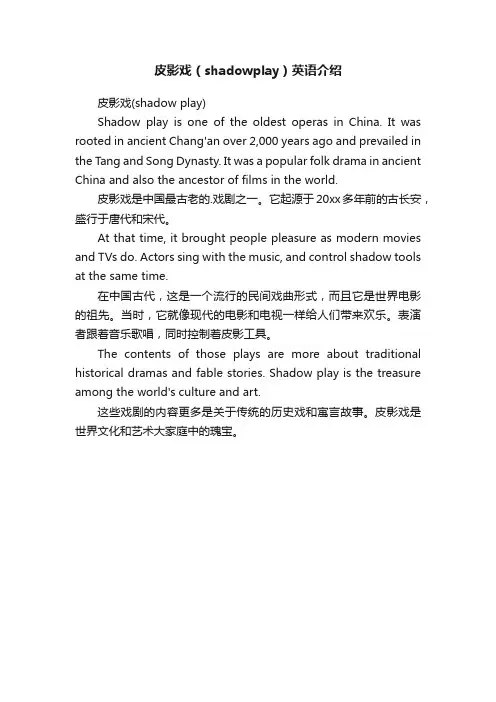
皮影戏(shadowplay)英语介绍
皮影戏(shadow play)
Shadow play is one of the oldest operas in China. It was rooted in ancient Chang'an over 2,000 years ago and prevailed in the Tang and Song Dynasty. It was a popular folk drama in ancient China and also the ancestor of films in the world.
皮影戏是中国最古老的.戏剧之一。
它起源于20xx多年前的古长安,盛行于唐代和宋代。
At that time, it brought people pleasure as modern movies and TVs do. Actors sing with the music, and control shadow tools at the same time.
在中国古代,这是一个流行的民间戏曲形式,而且它是世界电影的祖先。
当时,它就像现代的电影和电视一样给人们带来欢乐。
表演者跟着音乐歌唱,同时控制着皮影工具。
The contents of those plays are more about traditional historical dramas and fable stories. Shadow play is the treasure among the world's culture and art.
这些戏剧的内容更多是关于传统的历史戏和寓言故事。
皮影戏是世界文化和艺术大家庭中的瑰宝。
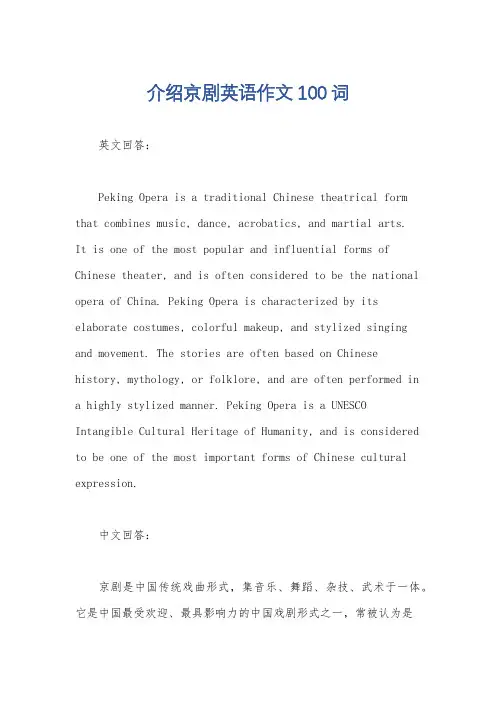
介绍京剧英语作文100词英文回答:Peking Opera is a traditional Chinese theatrical form that combines music, dance, acrobatics, and martial arts.It is one of the most popular and influential forms of Chinese theater, and is often considered to be the national opera of China. Peking Opera is characterized by its elaborate costumes, colorful makeup, and stylized singing and movement. The stories are often based on Chinese history, mythology, or folklore, and are often performed in a highly stylized manner. Peking Opera is a UNESCOIntangible Cultural Heritage of Humanity, and is considered to be one of the most important forms of Chinese cultural expression.中文回答:京剧是中国传统戏曲形式,集音乐、舞蹈、杂技、武术于一体。
它是中国最受欢迎、最具影响力的中国戏剧形式之一,常被认为是中国国粹。
京剧的特点是戏服精美、化妆浓艳、唱腔和动作程式化。
故事多取材于中国历史、神话或民间传说,且表演程式化程度较高。
京剧是联合国教科文组织人类非物质文化遗产,被认为是中国最重要的文化表现形式之一。
补充说明:京剧是中国传统文化的重要组成部分,在世界范围内享有很高的声誉。
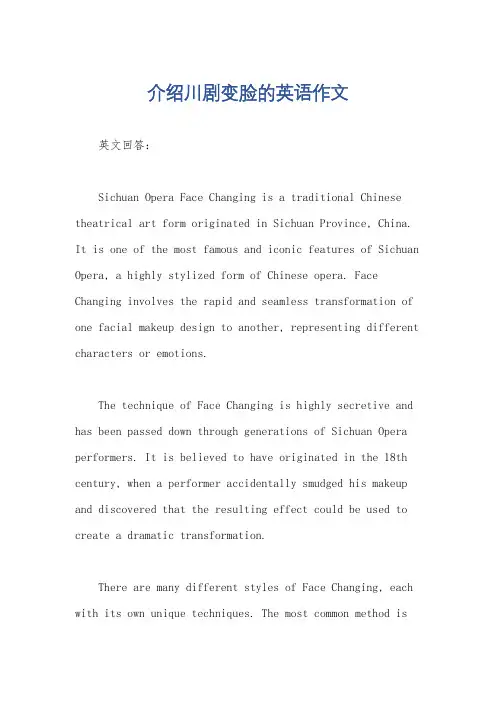
介绍川剧变脸的英语作文英文回答:Sichuan Opera Face Changing is a traditional Chinese theatrical art form originated in Sichuan Province, China. It is one of the most famous and iconic features of Sichuan Opera, a highly stylized form of Chinese opera. Face Changing involves the rapid and seamless transformation of one facial makeup design to another, representing different characters or emotions.The technique of Face Changing is highly secretive and has been passed down through generations of Sichuan Opera performers. It is believed to have originated in the 18th century, when a performer accidentally smudged his makeup and discovered that the resulting effect could be used to create a dramatic transformation.There are many different styles of Face Changing, each with its own unique techniques. The most common method is"blowing", which involves blowing air into a small piece of silk or paper that is attached to the performer's face. The silk or paper is then quickly pulled away, revealing the new makeup design. Other methods include "wiping", "pulling", and "sticking", which all involve usingdifferent tools or techniques to change the makeup.Face Changing is a highly skilled art form that requires years of practice to master. The performers must have excellent hand-eye coordination and the ability to control their facial muscles with precision. They must also be able to change their makeup quickly and seamlessly, without breaking character.Face Changing is more than just a theatrical trick. It is a powerful form of storytelling that can convey emotions and ideas in a visually striking and unforgettable way. It is an integral part of Sichuan Opera and continues to fascinate audiences around the world.中文回答:川剧变脸是中国传统戏剧艺术,源于中国四川省。
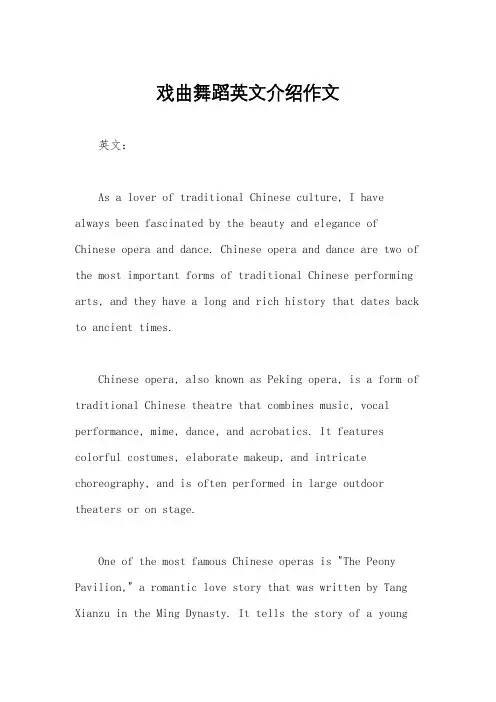
戏曲舞蹈英文介绍作文英文:As a lover of traditional Chinese culture, I have always been fascinated by the beauty and elegance of Chinese opera and dance. Chinese opera and dance are two of the most important forms of traditional Chinese performing arts, and they have a long and rich history that dates back to ancient times.Chinese opera, also known as Peking opera, is a form of traditional Chinese theatre that combines music, vocal performance, mime, dance, and acrobatics. It features colorful costumes, elaborate makeup, and intricate choreography, and is often performed in large outdoor theaters or on stage.One of the most famous Chinese operas is "The Peony Pavilion," a romantic love story that was written by Tang Xianzu in the Ming Dynasty. It tells the story of a youngwoman who falls in love with a scholar in a dream, and then dies of heartbreak when she wakes up and realizes that heis not real. The opera has been performed countless times over the centuries and is still beloved by audiences today.Chinese dance, on the other hand, is a form of dance that is characterized by its grace, fluidity, and expressiveness. It is often performed to traditional Chinese music and features intricate footwork, flowing arm movements, and dramatic poses.One of my favorite Chinese dances is the "Dragon Dance," which is performed during the Chinese New Year to bring good luck and prosperity. The dance features a long dragon made of cloth and bamboo, which is carried by a team of dancers who move in unison to create the illusion of a dragon that is alive and breathing fire.Overall, Chinese opera and dance are two of the most beautiful and captivating forms of traditional Chinese performing arts. They are a testament to the rich cultural heritage of China and continue to inspire and delightaudiences around the world.中文:作为一个热爱中国传统文化的人,我一直被中国戏曲和舞蹈的美丽和优雅所吸引。
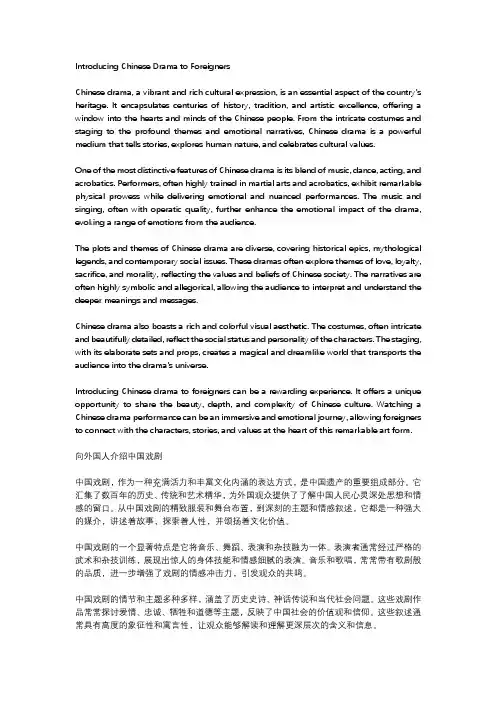
Introducing Chinese Drama to ForeignersChinese drama, a vibrant and rich cultural expression, is an essential aspect of the country's heritage. It encapsulates centuries of history, tradition, and artistic excellence, offering a window into the hearts and minds of the Chinese people. From the intricate costumes and staging to the profound themes and emotional narratives, Chinese drama is a powerful medium that tells stories, explores human nature, and celebrates cultural values.One of the most distinctive features of Chinese drama is its blend of music, dance, acting, and acrobatics. Performers, often highly trained in martial arts and acrobatics, exhibit remarkable physical prowess while delivering emotional and nuanced performances. The music and singing, often with operatic quality, further enhance the emotional impact of the drama, evoking a range of emotions from the audience.The plots and themes of Chinese drama are diverse, covering historical epics, mythological legends, and contemporary social issues. These dramas often explore themes of love, loyalty, sacrifice, and morality, reflecting the values and beliefs of Chinese society. The narratives are often highly symbolic and allegorical, allowing the audience to interpret and understand the deeper meanings and messages.Chinese drama also boasts a rich and colorful visual aesthetic. The costumes, often intricate and beautifully detailed, reflect the social status and personality of the characters. The staging, with its elaborate sets and props, creates a magical and dreamlike world that transports the audience into the drama's universe.Introducing Chinese drama to foreigners can be a rewarding experience. It offers a unique opportunity to share the beauty, depth, and complexity of Chinese culture. Watching a Chinese drama performance can be an immersive and emotional journey, allowing foreigners to connect with the characters, stories, and values at the heart of this remarkable art form.向外国人介绍中国戏剧中国戏剧,作为一种充满活力和丰富文化内涵的表达方式,是中国遗产的重要组成部分。
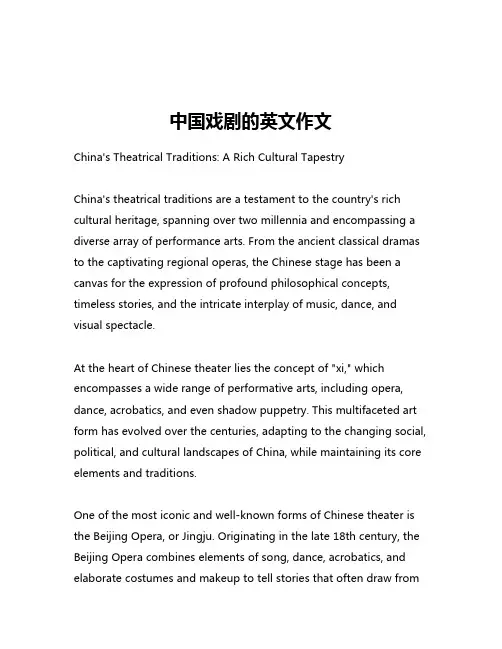
中国戏剧的英文作文China's Theatrical Traditions: A Rich Cultural TapestryChina's theatrical traditions are a testament to the country's rich cultural heritage, spanning over two millennia and encompassing a diverse array of performance arts. From the ancient classical dramas to the captivating regional operas, the Chinese stage has been a canvas for the expression of profound philosophical concepts, timeless stories, and the intricate interplay of music, dance, and visual spectacle.At the heart of Chinese theater lies the concept of "xi," which encompasses a wide range of performative arts, including opera, dance, acrobatics, and even shadow puppetry. This multifaceted art form has evolved over the centuries, adapting to the changing social, political, and cultural landscapes of China, while maintaining its core elements and traditions.One of the most iconic and well-known forms of Chinese theater is the Beijing Opera, or Jingju. Originating in the late 18th century, the Beijing Opera combines elements of song, dance, acrobatics, and elaborate costumes and makeup to tell stories that often draw fromChinese history, literature, and mythology. The intricate vocal techniques, the stylized movements, and the symbolic use of props and set pieces create a captivating and visually stunning experience for audiences.Beyond the Beijing Opera, China's theatrical landscape is further enriched by a diverse array of regional opera traditions, each with its own unique style, musical characteristics, and performance conventions. From the lyrical and melancholic Kunqu Opera of the Jiangsu and Zhejiang regions to the vibrant and energetic Cantonese Opera of southern China, these regional forms reflect the cultural diversity and artistic vibrancy of the country.The significance of Chinese theater extends beyond mere entertainment, as it serves as a vehicle for the transmission of cultural values, historical narratives, and philosophical ideas. The stories and characters portrayed on the stage often embody Confucian, Taoist, and Buddhist principles, exploring themes of morality, loyalty, and the human condition.One of the most remarkable aspects of Chinese theater is its ability to adapt and evolve over time, while still maintaining its core traditions. Throughout the tumultuous 20th century, which saw the rise and fall of dynasties, the emergence of modern China, and the challenges of globalization, Chinese theater has managed to reinventitself, incorporating new performance techniques, narratives, and artistic sensibilities, while preserving the essence of its rich heritage.In recent decades, the global recognition and appreciation of Chinese theater have grown significantly. Acclaimed productions from renowned troupes, such as the National Theatre of China and the Shanghai Peking Opera Theatre, have captivated audiences around the world, introducing the unique artistry and cultural significance of this ancient performative tradition to international audiences.As China continues to assert its presence on the global stage, the preservation and promotion of its theatrical traditions have become increasingly important. Efforts are being made to safeguard the intangible cultural heritage of Chinese theater, ensuring that these art forms are passed down to future generations and continue to inspire and captivate audiences both within China and beyond.In conclusion, Chinese theater is a remarkable and multifaceted art form that reflects the depth and diversity of the country's cultural legacy. From the grand spectacles of the Beijing Opera to the intimate and evocative regional traditions, the Chinese stage is a testament to the enduring power of storytelling, the fusion of artistic disciplines, and the profound cultural values that have shaped the nation's identity over the centuries. As China continues to evolve andengage with the world, the preservation and promotion of its theatrical traditions will undoubtedly play a crucial role in preserving and sharing its rich cultural heritage with the global community.。
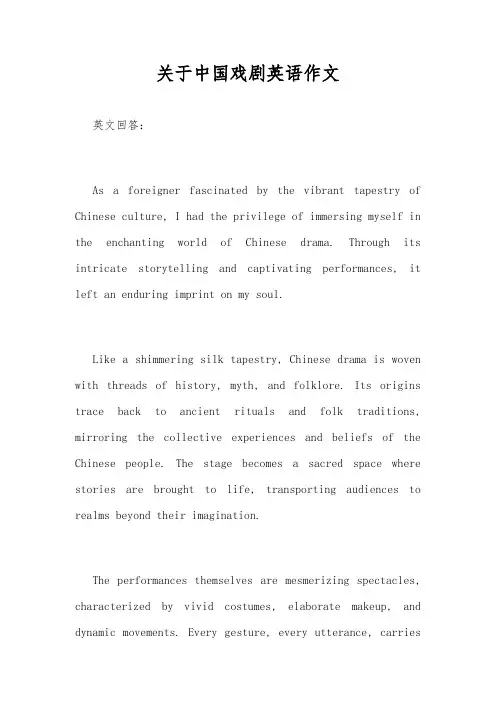
关于中国戏剧英语作文英文回答:As a foreigner fascinated by the vibrant tapestry of Chinese culture, I had the privilege of immersing myself in the enchanting world of Chinese drama. Through its intricate storytelling and captivating performances, it left an enduring imprint on my soul.Like a shimmering silk tapestry, Chinese drama is woven with threads of history, myth, and folklore. Its origins trace back to ancient rituals and folk traditions, mirroring the collective experiences and beliefs of the Chinese people. The stage becomes a sacred space where stories are brought to life, transporting audiences to realms beyond their imagination.The performances themselves are mesmerizing spectacles, characterized by vivid costumes, elaborate makeup, and dynamic movements. Every gesture, every utterance, carriesa profound significance, conveying a wealth of emotions and narratives. The actors, with their highly trained skills, embody their characters with such authenticity that the boundaries between performance and reality blur.Chinese drama is not merely entertainment. It serves as a mirror reflecting the complexities of human nature and the struggles and triumphs of society. Through its timeless tales of love, loss, and redemption, it explores the universal themes that resonate with audiences across time and cultures.In the vibrant streets of Beijing, I witnessed the captivating Peking Opera. The stage exploded with a symphony of colors and sounds, as actors adorned in elaborate costumes danced and sang with astonishing grace. The audience was spellbound, lost in a world of ancient stories and mythical creatures.In the serene gardens of Hangzhou, Kunqu Opera unfolded before my eyes. Its delicate melodies and gracefulmovements transported me to a realm of ethereal beauty. The actors' expressions, nuanced and subtle, conveyed a depth of emotion that left me breathless.As the curtain falls and the applause dies down, the enchantment of Chinese drama lingers. Its stories continue to echo in my mind, reminding me of the power of art to transcend time, cultures, and boundaries. It is an art form that weaves its way into the fabric of my soul, leaving an indelible mark that I will forever cherish.中文回答:作为一个沉迷于中华文化瑰宝的外国人,我有幸沉浸在迷人的中国戏剧的世界中。
介绍中国传统戏剧英语作文Chinese traditional drama, also known as xiqu, has a history of over 2,000 years and encompasses various forms such as Peking opera, Kunqu, Yueju, and Huangmei opera. Each form has its own unique style and characteristics, but they all share a common emphasis on storytelling, music, singing, and colorful costumes.The origins of Chinese traditional drama can be traced back to ancient rituals and ceremonies, where music and dance were used to communicate with the gods and ancestors. Over time, these rituals evolved into theatrical performances that were enjoyed by the general public, becoming an integral part of Chinese culture and tradition.One of the most distinctive features of Chinese traditional drama is the use of stylized movements and gestures, known as "mannered acting". Performers use their body language and facial expressions to convey emotions and tell the story, often accompanied by elaborate costumes andmakeup to enhance the visual impact.In addition to the physical aspects, Chinesetraditional drama also places great emphasis on music and singing. The actors are often required to be skilled in singing, as well as in playing traditional Chinese musical instruments such as the erhu, pipa, and gong. The music and singing not only serve to enhance the emotional impact of the performance, but also play a crucial role in setting the mood and atmosphere of the play.Another notable aspect of Chinese traditional drama is its repertoire of classic stories and characters, many of which are based on historical events, folklore, andliterary classics. These stories often explore themes of love, loyalty, betrayal, and heroism, and have been passed down through generations, continuing to captivate audiences with their timeless appeal.Despite the modernization and changes in society, Chinese traditional drama continues to thrive and evolve, with efforts to preserve and promote this ancient art form.In recent years, there has been a resurgence of interest in xiqu, with new generations of performers and audiences embracing and reinterpreting this rich cultural heritagefor the contemporary world.。
中国京剧英文介绍作文English Answer:Chinese Peking Opera, or Jingju, is a traditional Chinese theatrical form with a rich history and cultural significance. It combines elements of music, singing, dancing, acrobatics, and martial arts to create a captivating performance.Peking Opera originated in the mid-18th century during the Qing dynasty and quickly gained popularity among all social classes. It features a highly stylized and symbolic form of performance, with elaborate costumes, makeup, and stagecraft.The stories in Peking Opera are often drawn from Chinese history, mythology, and folklore. They typically revolve around themes of love, loyalty, betrayal, and revenge. The characters are archetypal and represent universal human emotions and experiences.Peking Opera is known for its distinctive vocal style, which uses a high-pitched, nasalized tone. The singing is often accompanied by a variety of percussion instruments, including drums, gongs, and cymbals. The performers also engage in intricate dance and acrobatic sequences, demonstrating their physical skills and flexibility.The makeup in Peking Opera is highly symbolic and helps to convey the character's personality and emotions. Each type of role has a specific makeup design, with different colors and patterns used to indicate different traits.Peking Opera is a living art form that continues to evolve and adapt to the changing times. It has been recognized by UNESCO as a Masterpiece of the Oral and Intangible Heritage of Humanity. Today, Peking Opera is performed in theaters around the world, continuing to captivate audiences with its beauty and artistry.中文回答:京剧,又称京剧,是一种具有悠久历史和文化意义的中国传统戏剧形式。
向外国人介绍中国戏剧的英语作文Chinese Drama: A Window into the Rich Cultural Heritage of China。
China, with its long and illustrious history, is a treasure trove of cultural heritage. Among the many art forms that have flourished in this ancient land, Chinese drama holds a special place. Chinese drama, also known as Peking Opera, is a traditional form of theater that combines music, dance, acrobatics, and martial arts. It is not only a source of entertainment but also a reflection of Chinese history, values, and traditions.Chinese drama dates back over 200 years, with its roots in the Qing Dynasty. It was during this time that the art form began to take shape and gain popularity among the masses. Over the years, Chinese drama has evolved and adapted, incorporating elements from various regional styles and folk traditions. Today, it is recognized as one of the most distinctive and influential forms of theater in the world.One of the defining features of Chinese drama is its elaborate costumes and makeup. The actors, both male and female, wear elaborate costumes that are rich in color and symbolism. The makeup, known as "jing," is applied in a stylized manner to exaggerate the facial features and express the character's emotions. Each color and pattern has a specific meaning, allowing the audience to easily identify the characters and their roles.Another characteristic of Chinese drama is its unique vocal style. The actors use a technique called "jinghuang," which involves a combination of singing and speaking. The melodies are often accompanied by traditional Chinese musical instruments such as the erhu and the pipa. The vocal style, combined with the expressive movements and gestures, creates a mesmerizing and immersive experience for the audience.Chinese drama is not only a form of entertainment but also a means of storytelling. Many of the plays are based on historical events, legends, and folk tales, offering a glimpse into China's rich cultural heritage. The stories often revolve around themes of loyalty, filial piety, and justice, reflecting the traditional values and moral teachings of Chinese society.In addition to its cultural significance, Chinese drama also showcases the incredible skills and talents of its performers. The actors undergo years of rigorous training to master the various techniques, including singing, dancing, acrobatics, and martial arts. Their performances are a testament to their dedication and passion for the art form.Chinese drama has not only captivated audiences within China but has also gained international recognition. It has been performed in countries around the world, introducing people from different cultures to the beauty and complexity of Chinese theater. In recent years, efforts have been made to promote and preserve Chinese drama, ensuring that future generations can continue to appreciate and enjoy this unique art form.In conclusion, Chinese drama is a window into the rich cultural heritage of China. It embodies the history, values, and traditions of the Chinese people and offers a unique and immersive theatrical experience. Through its elaborate costumes, distinctive vocal style, and captivating storytelling, Chinese drama has left an indelible mark on the world of theater. It is a testament to the creativity, talent, and resilience of the Chinese people and a source of pride for the nation.。
向外国人介绍中国戏剧的英语作文Introduction to Chinese DramaChinese drama, also known as Chinese opera, is a traditional form of performing arts that dates back thousands of years. With a rich history and a variety of regional styles, Chinese drama is a unique and vibrant aspect of Chinese culture.Types of Chinese DramaThere are several main types of Chinese drama, including Peking Opera, Cantonese Opera, Sichuan Opera, and Kunqu Opera. Each type has its own distinctive characteristics in terms of performance style, costumes, music, and themes.Peking Opera, also known as Beijing Opera, is one of the most well-known forms of Chinese drama. It combines singing, acting, martial arts, and acrobatics to tell historical, mythological, and literary stories. Peking Opera performers wear elaborate costumes and makeup, and often use stylized movements and gestures to convey emotions.Cantonese Opera is popular in southern China and Hong Kong, and features melodious singing and vibrant costumes. Sichuan Opera, from the Sichuan province, is known for itsfast-paced performances and face-changing techniques whereperformers change masks in the blink of an eye. Kunqu Opera, a classical form of Chinese opera, is recognized by UNESCO as a Masterpiece of the Oral and Intangible Cultural Heritage of Humanity.In addition to these main types of Chinese drama, there are also regional operas such as Shaoxing Opera, Yue Opera, and Henan Opera, each with its own unique style and repertoire.Themes and TechniquesChinese drama often explores themes of loyalty, love, heroism, and traditional Confucian values. Many Chinese dramas are based on historical events, legends, and folktales, and feature colorful characters such as valiant warriors, cunning villains, and virtuous maidens.In terms of techniques, Chinese drama is characterized by its highly stylized movements, gestures, and vocalizations. Performers may use symbolic gestures, intricate footwork, and martial arts techniques to convey emotions and actions. Music also plays a crucial role in Chinese drama, with traditional Chinese instruments such as the erhu, guzheng, and dizi providing accompaniment to the performances.Influences and AdaptationsChinese drama has had a profound influence on other forms of Asian performing arts, including Japanese Noh theater, Korean Pansori, and Vietnamese traditional opera. Chinese drama has also been adapted into modern forms such as films, television dramas, and contemporary theater productions.In recent years, there has been a growing interest in Chinese drama among international audiences, with performances and festivals held in countries around the world. Chinese opera troupes have also toured internationally, showcasing the beauty and diversity of Chinese drama to a global audience.ConclusionChinese drama is a vibrant and colorful art form that reflects the rich cultural heritage of China. With its diverse regional styles, themes, and techniques, Chinese drama continues to captivate audiences both in China and abroad. As a window into Chinese history, culture, and values, Chinese drama remains an important and cherished tradition that will continue to inspire and entertain audiences for generations to come.。